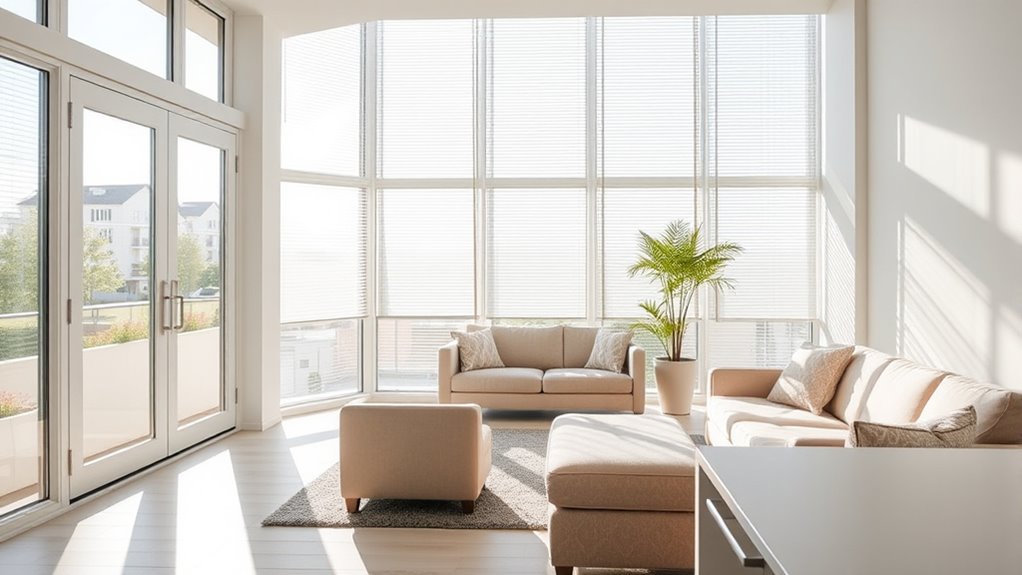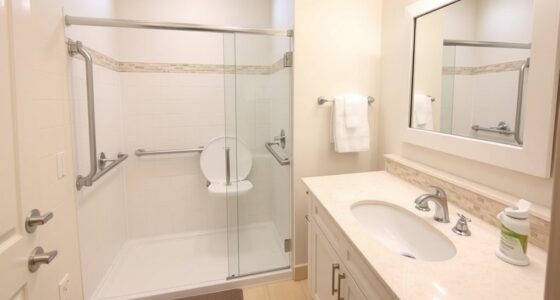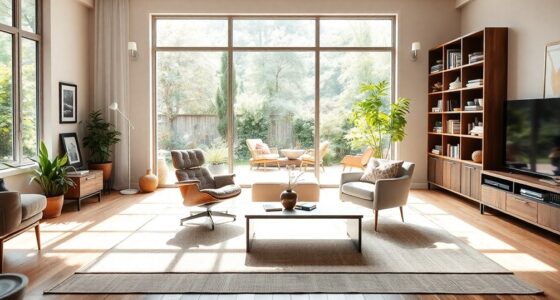Universal design at home centers on creating spaces that are accessible, flexible, and inclusive for everyone. You’ll want clear pathways, wide doorways, simple controls, and visible cues to make your home easy to navigate and safe. Incorporate assistive technologies and plan for future needs to guarantee lasting comfort. Focus on safety, error tolerance, and sensory engagement. Keep exploring these core principles to build a truly adaptable, welcoming environment for all residents.
Key Takeaways
- Ensure accessible entryways with at least 32-inch door clearance and clear pathways of 36 inches for easy navigation.
- Incorporate assistive technologies and adaptable features like smart devices and wider hallways to future-proof the home.
- Design intuitive layouts with clear controls, simple labels, and logical furniture placement for user-friendly operation.
- Use visual, auditory, and tactile signals with high contrast and clear symbols to accommodate diverse sensory needs.
- Prioritize safety by minimizing errors, reducing physical effort, and implementing slip-resistant surfaces and ergonomic designs.
Equitable Use
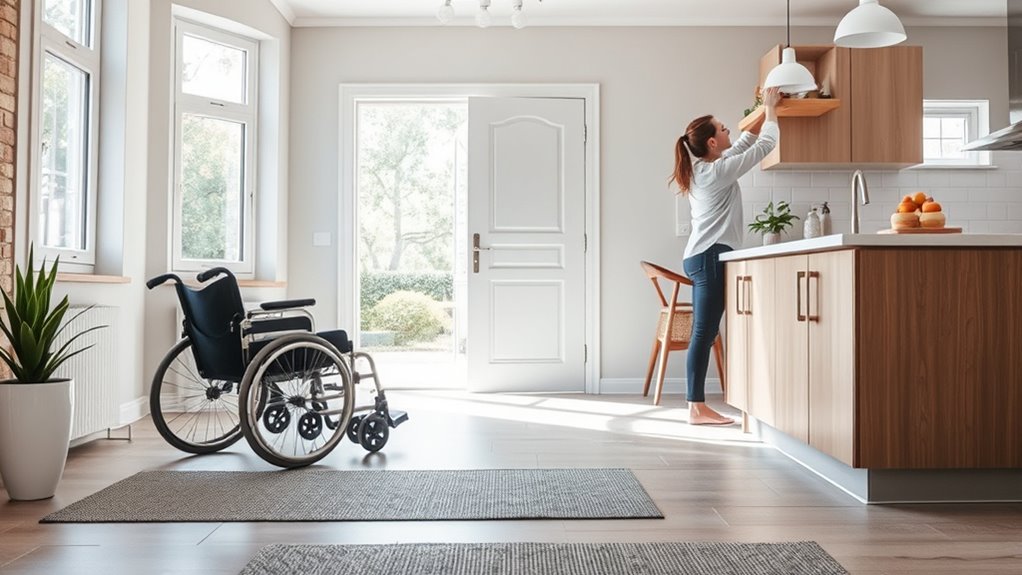
Equitable use guarantees that a home’s design is accessible and beneficial to everyone, regardless of their age, ability, or background. By embracing inclusive design principles, you guarantee that all users can navigate and enjoy the space comfortably. Universal accessibility means creating features that serve diverse needs, such as wide doorways, lever handles, and step-free entryways. These elements help people with mobility challenges and reduce barriers for everyone. When your home incorporates equitable design, you foster independence and safety for all occupants. It’s about designing with empathy, making sure no one feels excluded or struggles unnecessarily. In essence, equitable use helps create an environment where everyone can participate fully, promoting fairness and dignity in everyday living. Incorporating sound design principles can also enhance the sensory experience for all users, making spaces more welcoming and engaging.
Flexibility in Use
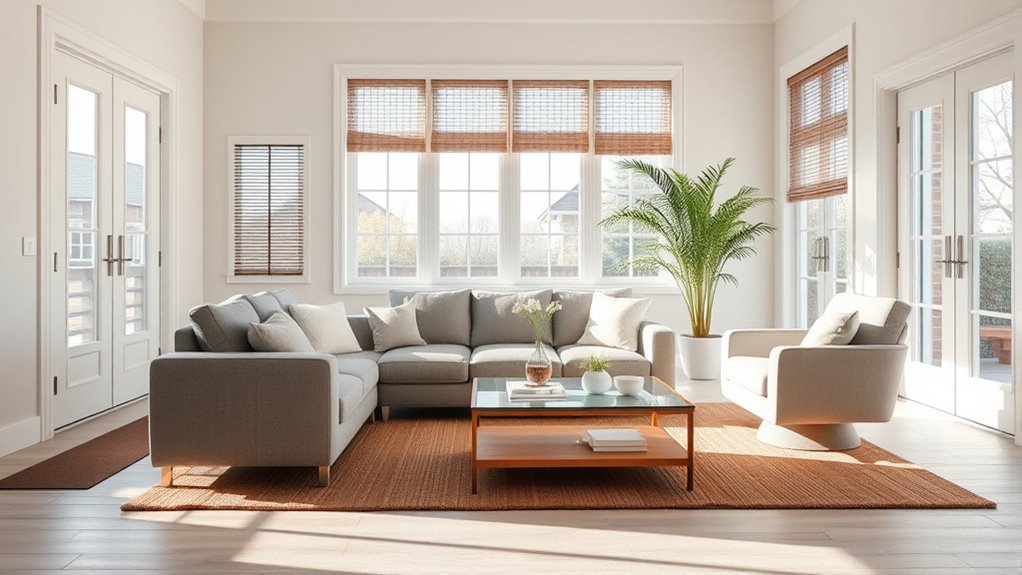
Flexibility in use allows your home to adapt to changing needs with ease. You can choose versatile furniture options, implement adjustable controls, and plan spaces that accommodate different functions. These features guarantee your home remains comfortable and functional for everyone. For example, incorporating adaptable transportation solutions like electric bike conversion kits can extend your mobility options and suit various lifestyle requirements.
Adaptable Space Planning
Have you ever considered how your living space can adapt to changing needs? Adaptive space planning allows you to modify rooms easily, ensuring your home remains functional for everyone. Using multi-use layouts and modular furniture, you can transform a living area into a guest bedroom or workspace in minutes. This flexibility supports different activities without overcrowding. Additionally, incorporating home furnishings like foldable furniture and adjustable features can enhance adaptability and convenience.
Versatile Furniture Options
Choosing versatile furniture can dramatically enhance your home’s adaptability. Multi functional furniture and modular pieces allow you to reconfigure spaces effortlessly, meeting changing needs. For example, consider:
- Convertible sofas that fold out into beds, perfect for guests.
- Modular shelving units that can be rearranged to fit different rooms and purposes.
- Extendable dining tables that adjust to accommodate more family or visitors.
These options maximize space without sacrificing style or functionality. Multi functional furniture provides dual or even triple uses, reducing clutter and increasing usability. Modular pieces give you the flexibility to adapt your environment quickly. Additionally, flexible design principles can help you create a layout that adapts seamlessly to your lifestyle’s evolving demands. By investing in these versatile furniture options, you create a more inclusive, adaptable home that responds to your lifestyle’s evolving demands.
Adjustable Controls
Adjustable controls play an essential role in creating a home that adapts to the needs of all users. By incorporating ergonomic handles, you make it easier for everyone to operate appliances and fixtures comfortably and safely. Tactile controls, such as textured buttons or dials, provide clear feedback, helping those with visual impairments or limited dexterity. You can install dimmer switches, flexible faucets, or thermostats that allow personalized settings, giving each person control over their environment. These features reduce frustration and increase independence. When controls are flexible and intuitive, your home becomes more inclusive. Prioritizing adjustable controls ensures everyone can use your space comfortably, promoting safety and convenience for family members and visitors alike. Incorporating accessible design features further enhances usability for individuals with diverse needs.
Simple and Intuitive Design
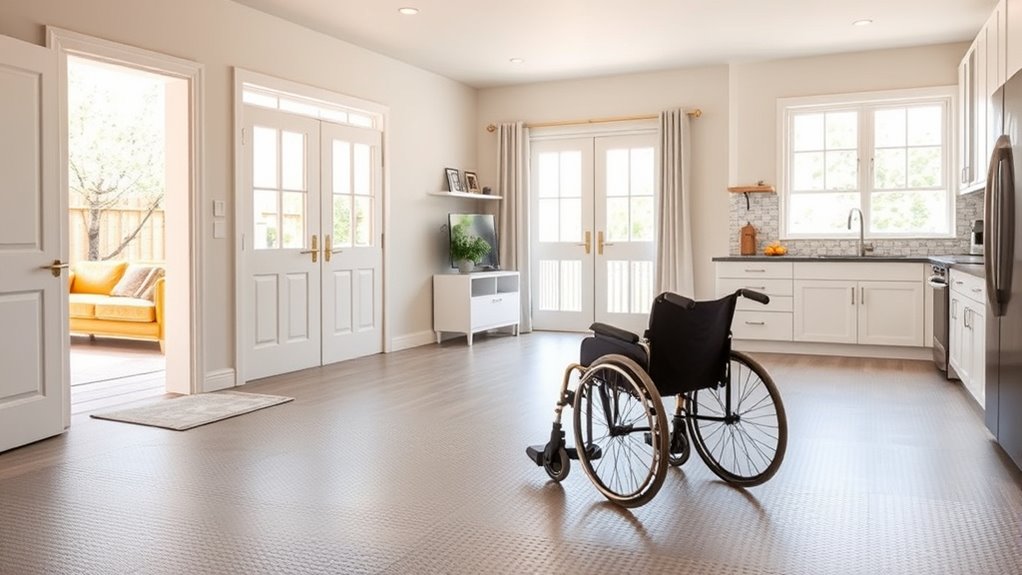
A simple and intuitive design guarantees that everyone can use your home without confusion or frustration. When applying universal design principles, focus on clarity and ease of use. Here are three ways to achieve this:
- Use straightforward, recognizable symbols and labels for switches, knobs, and appliances.
- Arrange controls and features in logical, accessible locations to reduce guesswork.
- Keep pathways clear and furniture placement intuitive, ensuring ease of movement.
- Regularly assess and update your layout with space and organization in mind to maintain functionality and comfort.
Perceptible Information
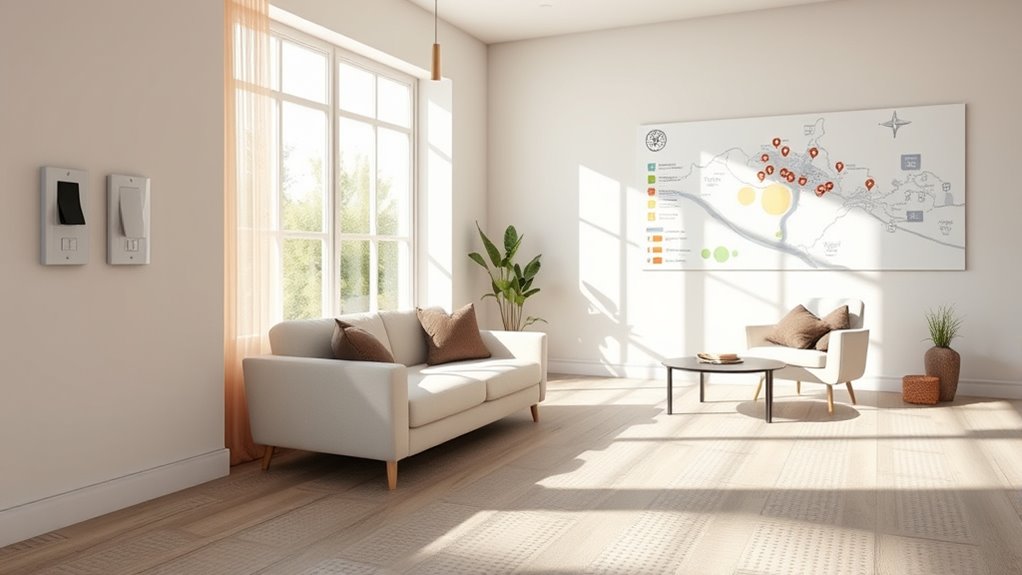
Clear and accessible information is vital to guarantee everyone can understand and respond to their environment. Perceptible information ensures that signals are visible, audible, or tactile, reducing confusion. Enhancing visual clarity helps you quickly identify important details, while a clear information hierarchy guides your attention efficiently. To achieve this, use contrasting colors, clear fonts, and consistent symbols. Structuring information effectively makes it easier to process and act on. Here’s a simple example:
| Element | Tip |
|---|---|
| Signage | Use large, high-contrast text |
| Alerts | Incorporate both visual and auditory cues |
| Labels | Keep labels simple and prominent |
| Instructions | Use step-by-step, easy-to-follow formats |
| Controls | Make controls distinguishable and tactile |
This approach guarantees perceptible information for everyone. Additionally, considering the use of accessible design principles enhances the overall effectiveness of information presentation.
Tolerance for Error
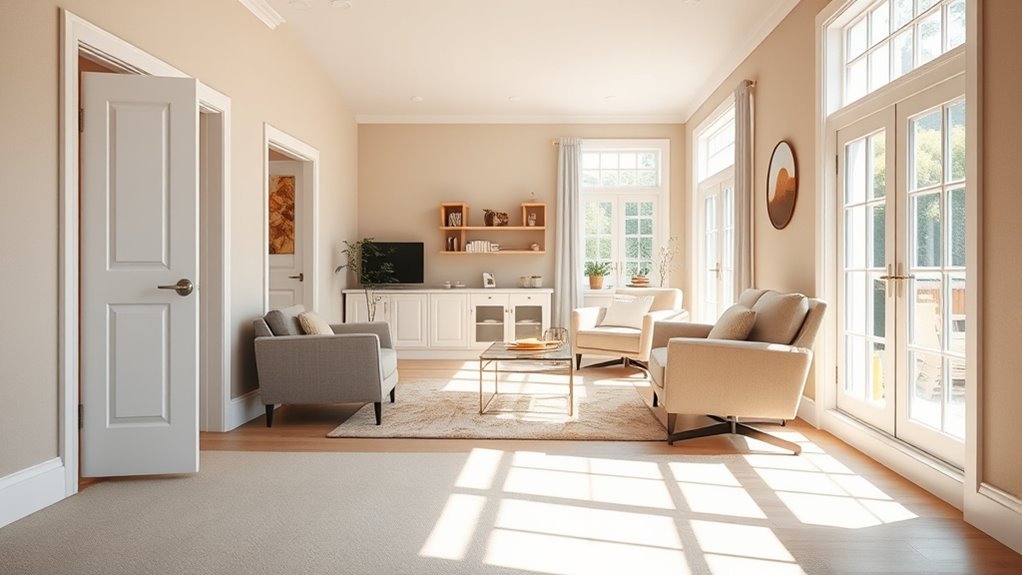
Designing for tolerance of error means creating environments and systems that minimize the consequences of mistakes and allow for safe correction. It’s about implementing mistake prevention strategies and facilitating error recovery. To achieve this, consider:
- Incorporating clear labels and visual cues to prevent errors.
- Using forgiving hardware and interfaces that allow easy correction of mistakes.
- Designing workflows that enable quick error recovery without significant disruption.
- Recognizing the significant financial impact that design choices can have on overall safety and efficiency.
Low Physical Effort
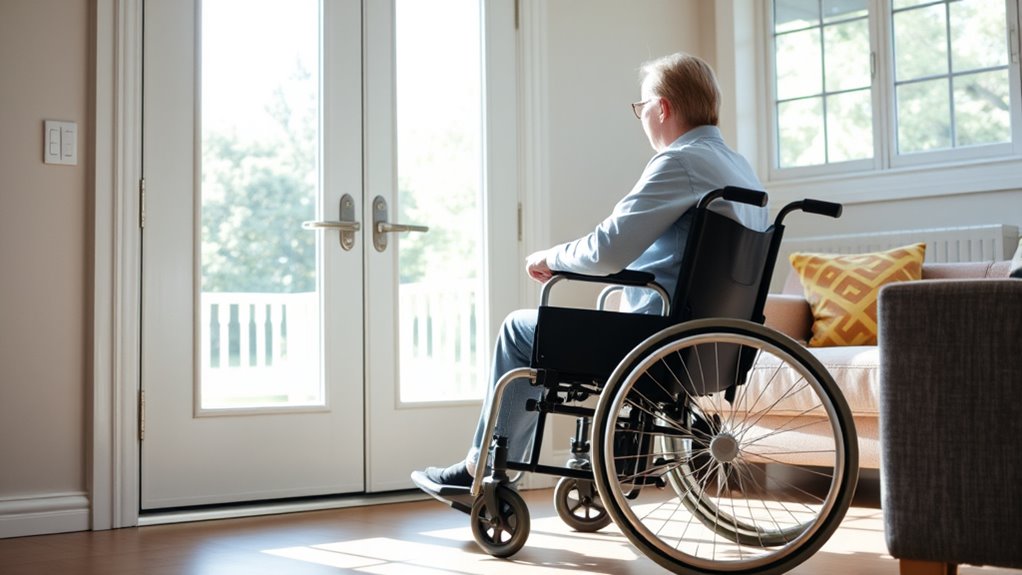
Reducing physical effort in home design guarantees that tasks require minimal strength, stamina, or dexterity, making everyday activities more accessible for everyone. An ergonomic kitchen features thoughtfully placed appliances, counter heights, and tools that lessen strain during food prep. Choosing slip resistant flooring enhances safety by preventing slips and falls, especially when you’re carrying items or moving quickly. These elements help you perform daily tasks with less effort, reducing fatigue and the risk of injury. Incorporating ergonomic design principles and safe flooring options ensures that tasks are easier to complete, promoting a functional and welcoming space for everyone. Additionally, selecting antique pieces that serve a purpose can add character without compromising accessibility or comfort.
Size and Space for Approach and Use
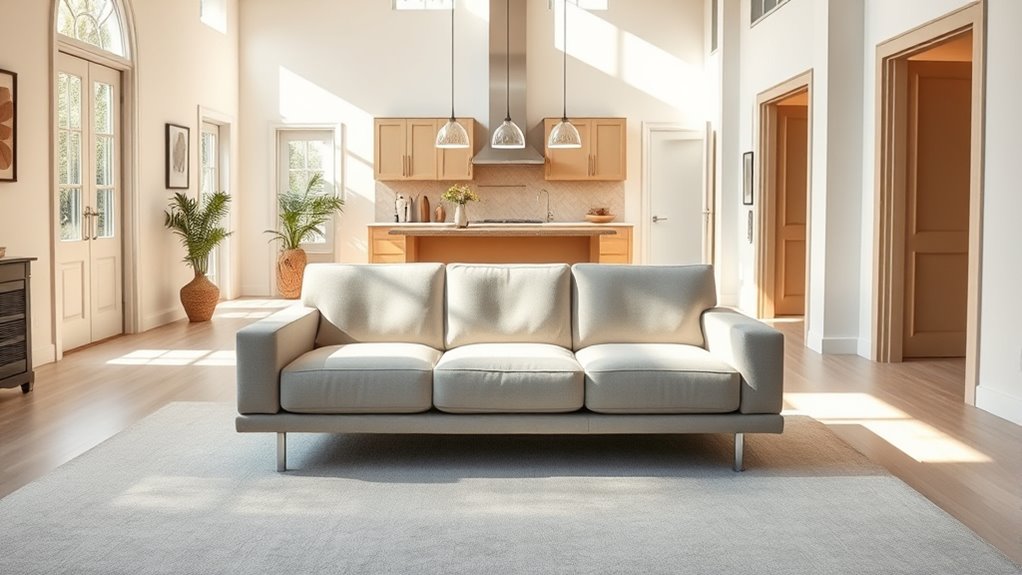
Ensuring there’s enough size and space for approach and use is essential to making your home accessible for everyone. Proper door clearance allows easy entry without obstruction, while strategic furniture placement prevents crowding and creates clear pathways. Consider these key points:
Creating ample space and clear pathways ensures your home is accessible and welcoming for all.
- Maintain at least 32 inches of door clearance for smooth passage.
- Leave a minimum of 36 inches of space in main walkways for easy navigation.
- Arrange furniture to avoid blocking doorways or pathways, ensuring unobstructed access.
These adjustments make it easier for all users to approach and use areas comfortably. Adequate size and space not only improve safety but also foster independence, especially for those with mobility aids or limited mobility. Incorporating Universal Design principles can further enhance accessibility and inclusivity within your home. Prioritizing these elements creates a more inclusive, functional living environment.
Incorporating Assistive Technologies
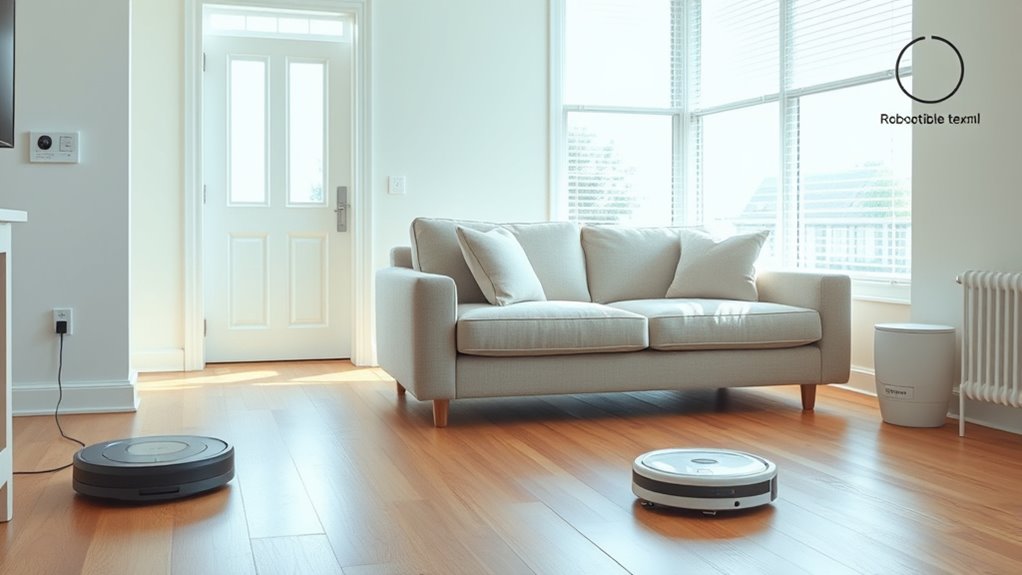
Incorporating assistive technologies can make your home more accessible and convenient. Smart home devices, voice-activated systems, and automated lighting allow you to control your environment effortlessly. These tools help create a safer, more adaptable space tailored to your needs.
Smart Home Devices
Smart home devices have revolutionized the way we live by making everyday tasks more accessible and convenient for everyone. They can enhance comfort, safety, and energy efficiency in your home. To maximize these benefits, consider these key points:
- Privacy concerns: Make sure your devices have strong security features to protect personal data.
- Energy efficiency: Use smart thermostats and lighting to reduce energy consumption and lower utility bills.
- Assistive integration: Devices like automated door locks and remote-controlled appliances support independence for all users.
Voice-Activated Systems
Voice-activated systems have become essential assistive technologies that make home navigation and control easier for everyone. With voice control, you can operate devices hands-free, reducing physical effort and increasing independence. Digital assistants like Alexa, Google Assistant, or Siri respond to your commands, allowing you to adjust thermostats, play music, or check the weather effortlessly. These systems are especially helpful for individuals with mobility challenges or visual impairments, providing seamless access to home functions. By integrating voice-activated systems into your home, you create a more inclusive environment that adapts to your needs. They promote safety and convenience, enabling you to manage your surroundings without physical strain. Overall, voice control with digital assistants enhances your home’s accessibility, supporting a more comfortable, autonomous lifestyle.
Automated Lighting
Automated lighting systems enhance home accessibility by allowing you to control lights effortlessly, often through voice commands, motion sensors, or timers. They make managing your space safer and more convenient, especially for those with mobility challenges. Plus, automated lighting boosts energy efficiency by ensuring lights are on only when needed. To maximize benefits, consider:
- Installing motion sensors in key areas to turn lights on or off automatically
- Using timers to schedule lighting during specific times
- Integrating voice-activated controls for seamless operation
These features help create a more inclusive environment while reducing energy costs. Automated lighting not only simplifies your daily routine but also aligns with universal design principles, making your home safer, more efficient, and easier to manage for everyone.
Planning for Future Changes
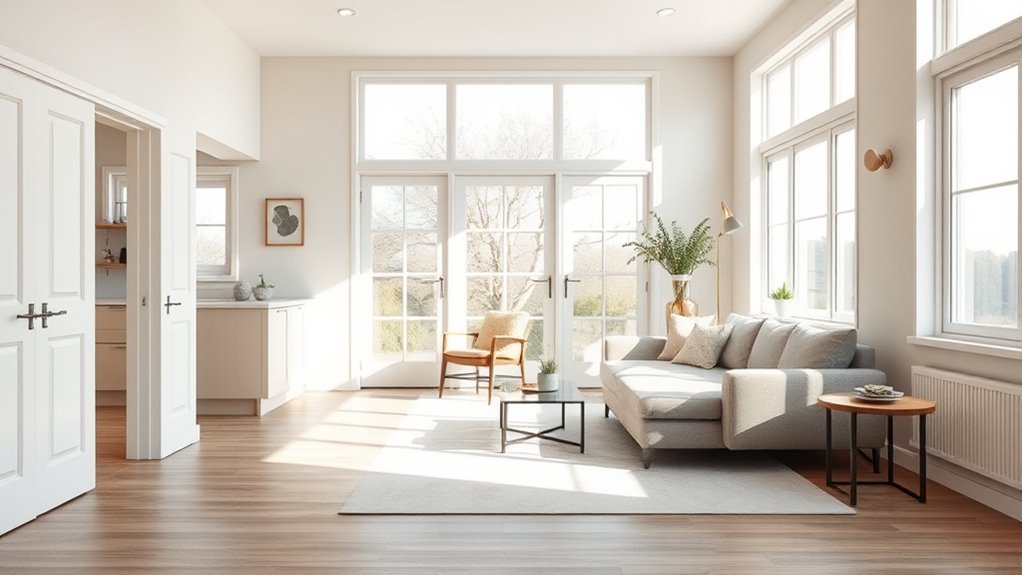
Have you contemplated how your home can adapt as your needs change over time? Planning for future changes involves incorporating future proofing design and aging in place strategies now, so your space remains functional and comfortable later. Think about wider doorways and hallways to accommodate mobility devices, or installing lever handles instead of knobs for easier use. It’s also wise to consider adjustable countertops, walk-in showers, and accessible switches and outlets. By proactively designing with flexibility in mind, you avoid costly renovations down the line and ensure your home continues to meet your needs. This forward-thinking approach helps you maintain independence and safety, no matter how your circumstances evolve. Preparing now means your home can adapt seamlessly as you age or face changing abilities.
Creating a Sense of Community and Inclusivity
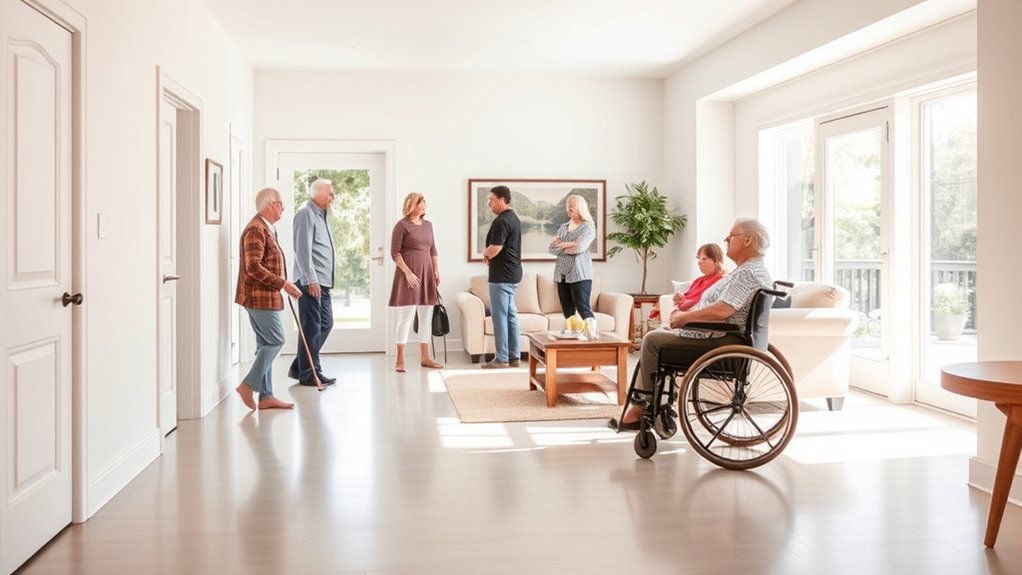
Creating a sense of community starts with designing spaces that welcome everyone and make them feel included. When you celebrate diversity together, you foster connections and build understanding among all residents. By intentionally creating welcoming environments, you help cultivate a true sense of belonging at home.
Welcoming Spaces for All
How can your home feel more welcoming and inclusive for everyone? Start by considering these key elements:
- Use multisensory design to engage sight, sound, and touch, creating a comforting environment for all.
- Incorporate cultural inclusivity by including diverse art, decor, and symbols that reflect different backgrounds.
- Create flexible spaces that adapt to different needs, ensuring everyone feels comfortable and valued.
Celebrating Diversity Together
Building a sense of community begins with celebrating the diverse backgrounds and experiences that make your home unique. Embrace inclusive design by creating spaces that reflect and honor different cultures and traditions. Incorporate elements that promote cultural sensitivity, ensuring everyone feels valued and respected. This might include artwork, language, or design features that celebrate various heritages. When your home welcomes diverse perspectives, it fosters understanding and connection among all who visit or live there. By intentionally designing with inclusivity in mind, you create an environment where everyone feels comfortable and appreciated. Celebrating diversity together not only enriches your home but also strengthens the bonds that build a true sense of community and belonging.
Frequently Asked Questions
How Does Universal Design Benefit Aging Populations at Home?
You benefit from universal design at home as it makes daily living safer and more comfortable for aging populations. Assistive technologies, like grab bars and non-slip floors, help prevent falls and injuries. Aesthetics considerations guarantee your home remains attractive and welcoming. With these features, you can maintain independence longer, enjoy a functional space, and feel confident that your home adapts to your changing needs without sacrificing style.
What Are Budget-Friendly Options for Implementing Universal Design Principles?
You can implement budget-friendly universal design principles by focusing on affordable modifications and DIY adaptations. For example, add grab bars with simple installation, use non-slip mats, and widen doorways with inexpensive tools. You might also repaint or rearrange furniture for better accessibility. These cost-effective solutions improve safety and comfort, making your home more functional without breaking the bank. Embrace DIY projects to customize your space easily and affordably.
How Can Universal Design Accommodate Different Cultural Preferences?
You can embrace cultural adaptations and design diversity by incorporating elements that reflect different traditions and preferences into your home. Choose colors, patterns, and furniture styles that resonate with your cultural background, while maintaining accessibility features. Involving family members or community members in the design process guarantees the space feels inclusive and personalized. This approach creates a welcoming environment that respects and celebrates diverse cultural identities through thoughtful universal design.
What Training Is Needed for Homeowners to Apply Universal Design?
Think of home modification like learning a new dance—it requires practice and understanding. To apply universal design, you need training on accessibility standards and practical modifications. Workshops, online courses, and consulting professionals teach you to create inclusive spaces. For example, knowing how to install wider doorways or lever handles guarantees your home is accessible for all ages and abilities. This knowledge empowers you to make thoughtful, functional changes confidently.
How Does Universal Design Impact Property Value and Resale Potential?
Universal design can boost your property value and resale potential by making your home more accessible and attractive to a wider range of buyers. When you incorporate features like wider doorways, no-step entries, and adaptable spaces, you create a more functional and appealing home. These enhancements often lead to higher appraisals and increased demand, helping you sell faster and at a better price, regardless of future buyers’ needs.
Conclusion
By embracing universal design, you create a home where everyone feels welcome—like a welcoming lighthouse guiding all safely ashore. You guarantee spaces are intuitive, adaptable, and inclusive, fostering independence and connection. Think of your home as a garden that blooms year-round, supporting growth and change. With these core principles, you craft more than a house—you build a sanctuary where diversity is celebrated and everyone can thrive.
